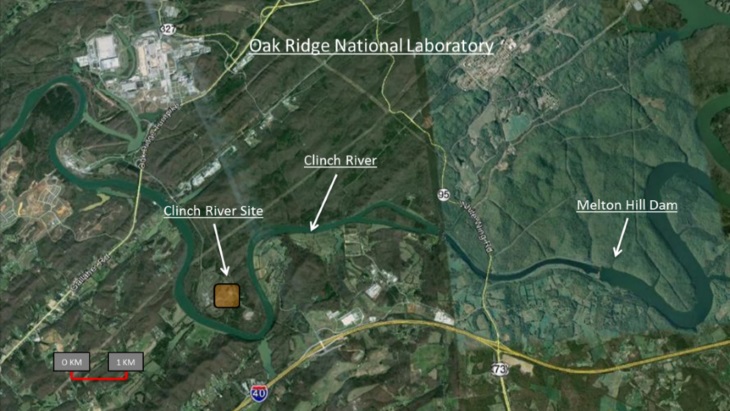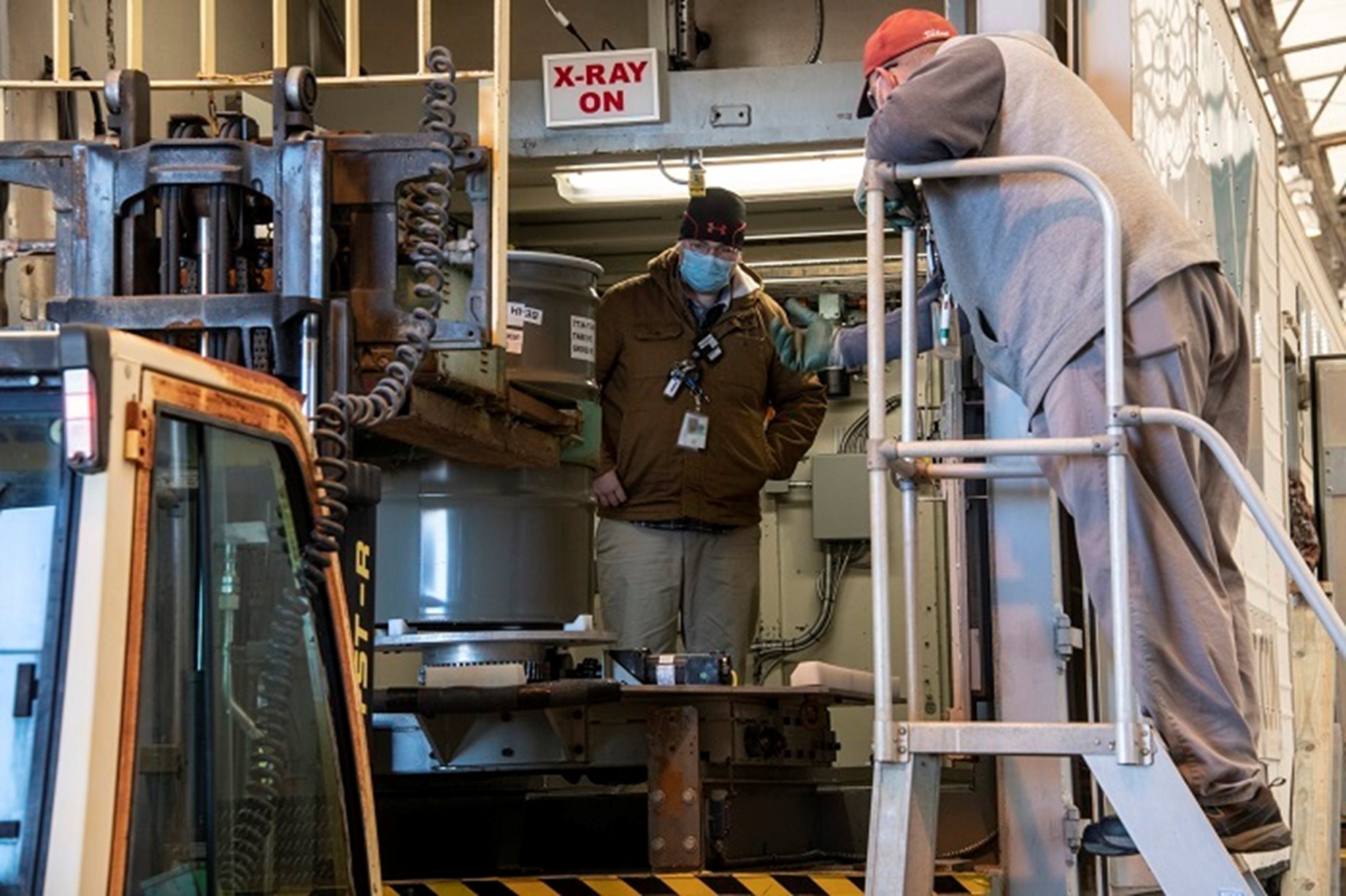Fuel preparing to be unloaded outside of Vogtle-3 last month. (Photo: Georgia Power)
Commercial operation dates for the two new reactors under construction at the Vogtle nuclear plant have been pushed back yet again, adding to the project’s total cost, Southern Company announced last week. The Vogtle plant is near Waynesboro, Ga.
During its February 17 fourth-quarter earnings call, Southern reported that the projected start dates for both reactors were being extended by three to six months. Vogtle-3 is now expected to begin providing electricity to Georgians in the fourth quarter of 2022 or first quarter of 2023, with Vogtle-4 coming on line in the third or fourth quarter of 2023.
Instrumentation at Oak Ridge National Laboratory’s Spallation Neutron Source, an accelerator-based facility that provides the most intense pulsed neutron beams in the world for scientific research and industrial development. (Photo: ORNL)
Researchers advancing particle accelerator technology for medical, security, energy, and industrial applications have a new funding opportunity announced on February 16 by the Department of Energy’s Office of Science (DOE-SC). The funding will support research to advance particle accelerator technology for medical, security, energy, and industrial applications. Grants will be awarded for work focused on innovation, technology transfer, and supply chain resiliency that falls under one of two DOE-SC programs: the Accelerator Stewardship program, which supports cross-disciplinary teams to solve high-impact problems, and the Accelerator Development program, which is aimed at strengthening domestic suppliers of accelerator technology.
An aerial view of Ontario’s Darlington Nuclear Generating Station. (Photo: OPG)
Ontario Power Generation has passed the midway point in its C$12.8 billion (about $10 billion) Darlington nuclear plant refurbishment project with the start of work on Unit 1, the company has announced. The unit is expected to be ready for grid reconnection in the second quarter of 2025.
Darlington houses four 878-MWe CANDU pressurized heavy water reactors, all of which entered commercial operation in the early 1990s. The plant is located in Clarington, Ontario, Canada.
An advanced nuclear reactor technology park is hoped for the 935-acre Clinch River site. Image: TVA
Last week’s announcement from the Tennessee Valley Authority about its “New Nuclear Program,” which outlines the potential development of the Clinch River site near Oak Ridge National Laboratory in Eastern Tennessee, is the catalyst for this week’s #ThrowbackThursday post. The Clinch River site was originally planned to be the location for the Clinch River Breeder Reactor, a project that, at the time, was meant to be the future of the nuclear industry in the United States.
The Diablo Canyon nuclear power plant
The San Luis Obispo County Board of Supervisors earlier this week endorsed extending the life of Diablo Canyon—California’s last operating nuclear power facility—which owner and operator Pacific Gas and Electric Company has scheduled for permanent closure in 2025. The two-unit, 2,289-MWe plant is located in San Luis Obispo County, near Avila Beach.
Holtec’s HI-STAR 190 spent nuclear fuel transport cask. India’s NPCIL ordered the company’s smaller HI-STAR 149 cask for use at its Kudankulam plant. (Photo: Holtec)
Holtec International announced yesterday that its India-based subsidiary, Holtec Asia, has received an order from Mumbai-based Nuclear Power Corporation of India Limited (NPCIL) for two HI-STAR 149 transport casks to serve the away-from-reactor storage facility for the Kudankulam nuclear power plant.
Operators load a TRU waste drum into a real-time radiography unit for characterization at the Solid Waste Management Facility at the Savannah River Site. (Photos: DOE)
Operators at the Savannah River Site’s Solid Waste Management Facility can now characterize and certify newly generated TRU waste through the use of a real-time radiography unit that uses an X-ray system to examine the contents of waste containers. The equipment was recently installed to meet updated requirements set by the Department of Energy’s National TRU Program that involve evaluating the containers for chemical compatibility and oxidizing chemicals.
The shipments of TRU waste from SRS, in South Carolina, are sent to the Waste Isolation Pilot Plant (WIPP), in New Mexico, for disposal.
John Hopkins (left), NuScale Power’s president and CEO, and Marcin Chludziński, president of KGHM’s management board, sign the agreement on February 14. (Photo: Business Wire)
At an event held on February 14 at the Chamber of Commerce in Washington, D.C., small modular reactor developer NuScale Power inked an agreement with KGHM Polska Miedz S.A., to initiate deployment of NuScale’s SMR technology in Poland.
The Relativistic Heavy Ion Collider at Brookhaven National Laboratory. (Photo: DOE)
The Department of Energy has announced an $18 million funding opportunity for research and development in particle accelerator science and technology for nuclear physics research. Provided through the DOE’s Office of Science, the funding is intended to support “efforts essential to developing world-leading core competencies and transformative technologies that significantly advance the state-of-the-art accelerator capabilities.”
The interior of the Submarine 1st Generation Westinghouse prototype, located at the Naval Reactors Facility on the INL site, circa mid-1950s. (Photo: DOE)
The Department of Energy’s Office of Environmental Management (EM) announced on February 10 that it is set to deactivate and demolish the prototype for the reactor used for the USS Nautilus, the world’s first operational nuclear-powered submarine and the first submarine to complete a submerged transit of the North Pole.
[Click to view full image] Cutaway of the HPR1000 design. (Image: CGN)
The Office for Nuclear Regulation (ONR) and the Environment Agency (EA) have found the UK HPR1000 reactor suitable for construction in the United Kingdom, the regulators jointly announced last week.







.jpg)













